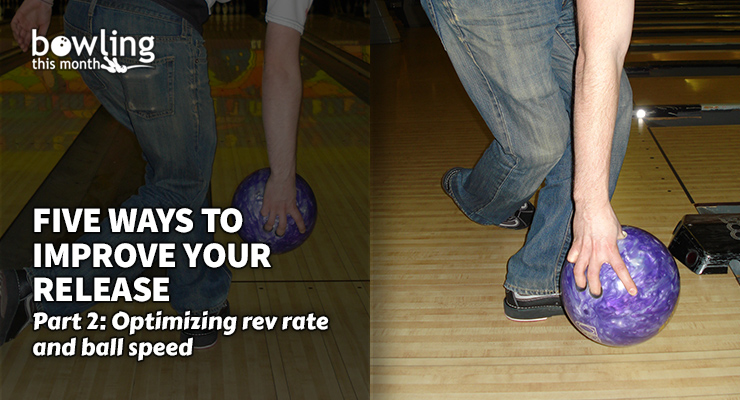Article Contents
- 1. Speed-dominant versus rev-dominant
- 2. Optimizing your release
- 3. Increasing your rev rate
- 3.1. Creating more leverage
- 3.2. Putting in the work
- 3.3. What about the three-step drill?
- 4. Decreasing ball speed
- 4.1. Slowing down your feet
- 4.2. Lowering your swing height
- 5. Final thoughts
Note: This article is only available to Bowling This Month subscribers.
In the first part of this series, I introduced the five parameters of the release that a bowler can improve: direction, ball speed, rev rate, axis rotation, and axis tilt. We started by exploring release direction, discussing how to improve both consistency and versatility. For this article, we’ll talk about optimizing your rev rate and ball speed.
Usually, when discussing the release, bowlers focus on rev rate, axis rotation, and axis tilt, but the relationship between your rev rate and ball speed is arguably the most important part of your game. While axis rotation and tilt significantly influence your ball motion, they are secondary to the relationship between rev rate and ball speed.
Speed-dominant versus rev-dominant
What does it mean to be speed-dominant or rev-dominant? Because this definition impacts everything from your lane play strategies to your ball layouts, it’s important to understand this part of your game.
To help bowlers and coaches understand the relationship between rev rate and ball speed, Juha Maja introduced a simple calculation: divide your rev rate in RPMs by your ball speed in mph.
I’ve started referring to this relationship as a bowler’s rev rate optimization score, or ROS. An ROS above 25 is considered rev-dominant, while a score below 20 is considered speed-dominant. Balanced bowlers—where their rev rate matches up well to their speed—score between 20 and 25.
Optimizing your release
Despite balanced bowlers being defined as having an ROS between 20 and 25, the modern game of bowling tends to favor bowlers toward the rev-dominant side of the scale. For this reason, a high-level bowler’s goal should be to achieve an ROS between 22 and 27.
As an example, if you look at the recent PBA Tournament of Champions finalists, most of the bowlers had an ROS between 24 and 27. The only exception was the champion, Jesper Svensson, who is even higher, with an ROS in the 28 to 29 range.
The more rev-dominant you are, the more urethane will help your game. This is why you almost never see Jesper using anything but urethane.
While rev-dominant players can be limited in the equipment choices they have, it’s most often the speed-dominant players who see their release as a weakness. If you’re ...
Already a premium member? Click here to log in.


 (Only
(Only 